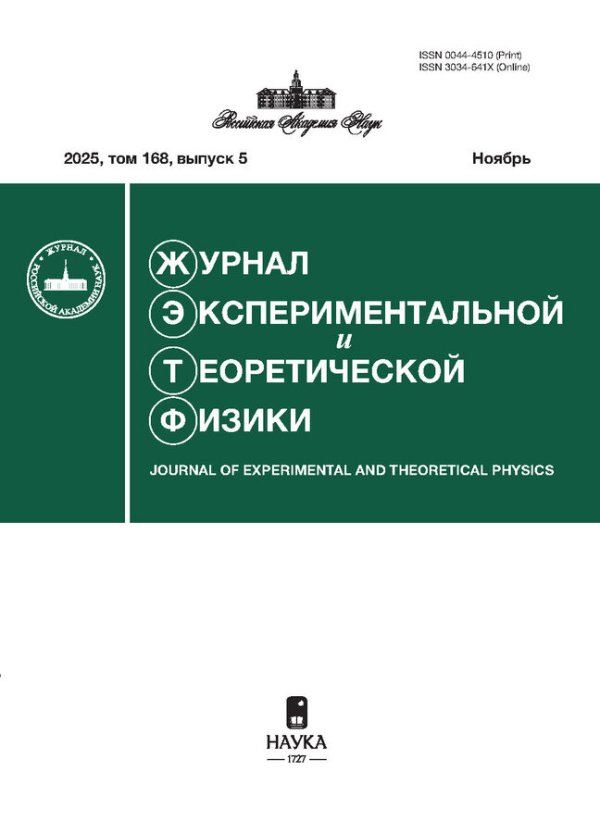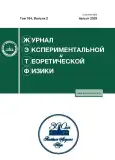Scalable Heteronuclear Architecture of Neutral Atoms Based on EIT
- Authors: Faruk A.M.1,2,3, Beterov I.I.1,3,4,5, Pen S.6,7, Ryabtsev I.I.1,3
-
Affiliations:
- Novosibirsk State University
- Faculty of Science, Al-Azhar University
- Rzhanov Institute of Semiconductor Physics, Siberian Branch of Russian Academy of Sciences
- Institute of Laser Physics, Siberian Branch of Russian Academy of Sciences
- Novosibirsk State Technical University
- State Key Laboratory of Magnetic Resonance and Atomic and Molecular Physics, Innovation Academy for Precision Measurement Science and Technology, Chinese Academy of Sciences
- Wuhan Institute of Quantum Technology
- Issue: Vol 164, No 2 (2023)
- Pages: 230-240
- Section: Articles
- URL: https://journal-vniispk.ru/0044-4510/article/view/148046
- DOI: https://doi.org/10.31857/S0044451023080096
- EDN: https://elibrary.ru/IAYWOR
- ID: 148046
Cite item
Full Text
Abstract
Based on our recent paper [arXiv:2206.12176 (2022)], we propose a scalable heteronuclear architecture of parallel implementation of CNOT gates in arrays of alkali-metal neutral atoms for quantum information processing. We considered a scheme where we perform CNOT gates in a parallel manner within the array, while they are performed sequentially between the pairs of neighboring qubits by coherently transporting an array of atoms of one atomic species (ancilla qubits) using an array of mobile optical dipole traps generated by a 2D acousto-optic deflector (AOD). The atoms of the second atomic species (data qubits) are kept in the array of static optical dipole traps generated by spatial light modulator (SLM). The moving ancillas remain in the superposition of their logical ground states without loss of coherence, while their transportation paths avoid overlaps with the spatial positions of data atoms. We numerically optimized the system parameters to achieve the fidelity for parallelly implemented CNOT gates around
About the authors
A. M. Faruk
Novosibirsk State University;Faculty of Science, Al-Azhar University;Rzhanov Institute of Semiconductor Physics, Siberian Branch of Russian Academy of Sciences
Email: ahmed.farouk@azhar.edu.eg
Novosibirsk, 630090 Russia;Cairo, 11884 Egypt;Novosibirsk, 630090 Russia
I. I. Beterov
Novosibirsk State University;Rzhanov Institute of Semiconductor Physics, Siberian Branch of Russian Academy of Sciences;Institute of Laser Physics, Siberian Branch of Russian Academy of Sciences;Novosibirsk State Technical University
Email: beterov@isp.nsc.ru
Novosibirsk, 630090 Russia;Novosibirsk, 630090 Russia;Novosibirsk, 630090 Russia;Novosibirsk, 630073 Russia
Syuy Pen
State Key Laboratory of Magnetic Resonance and Atomic and Molecular Physics, Innovation Academy for Precision Measurement Science and Technology, Chinese Academy of Sciences; Wuhan Institute of Quantum Technology
Email: beterov@isp.nsc.ru
Wuhan, 430071 China; Wuhan, 430206 China
I. I. Ryabtsev
Novosibirsk State University;Rzhanov Institute of Semiconductor Physics, Siberian Branch of Russian Academy of Sciences
Author for correspondence.
Email: beterov@isp.nsc.ru
Novosibirsk, 630090 Russia; Novosibirsk, 630090 Russia
References
- S. Ebadi, T. T. Wang, H. Levine et al., Nature 595, 227 (2021).
- P. Scholl, M. Schuler, H. J. Williams et al., Nature 595, 233 (2021).
- T. M. Graham, Y. Song, J. Scott et al., Nature 604, 457 (2022).
- I. S. Madjarov, J. P. Covey, A. L. Shaw et al., Nature Physics 16, 857 (2020).
- W. H¨ansel, J. Reichel, P. Hommelho, and T. W. H¨ansch, Phys. Rev. Lett. 86, 608 (2001).
- J. Beugnon, C. Tuchendler, H. Marion et al., Nature Phys. 3, 696 (2007).
- G. T. Hickman and M. Sa man, Phys. Rev. A 101101, 063411 (2020).
- D. Bluvstein, H. Levine, G. Semeghini et al., Nature 604, 451 (2022).
- K. Singh, S. Anand, A. Pocklington et al., Phys. Rev. X 12, 011040 (2022).
- C. Sheng, J. Hou, X. He et al., Phys. Rev. Lett. 128, 083202 (2022).
- C. Zhang and M. R. Tarbutt, PRX Quantum 3, 030340 (2022).
- T. G. Walker and M. Sa man, Phys. Rev. A 77, 032723 (2008).
- I. I. Beterov and M. Sa man, Phys. Rev. A 92, 042710 (2015).
- Z. Tao, L. Yu, P. Xu et al., Chin. Phys. Lett. 39, 083701 (2022).
- S. Ebadi, A. Keesling, M. Cain et al., Science 376, 1209 (2022).
- M. Nguyen, J. Liu, J. Wurtz et al., PRX Quantum 4, 010316 (2023).
- A. Byun, M. Kim, and J. Ahn, PRX Quantum 3, 030305 (2022).
- M. Kim, K. Kim, J. Hwang et al., Nature Phys. 18, 755 (2022).
- F. Arute, K. Arya, R. Babbush et al., Nature 574, 505 (2019).
- M. Mu¨ller, I. Lesanovsky, H. Weimer et al., Phys. Rev. Lett. 102, 170502 (2009).
- K. McDonnell, L. F. Keary, and J. D. Pritchard, Phys. Rev. Lett. 129, 200501 (2022).
- A. M. Farouk, I. I. Beterov, P. Xu et al., ArXiv: 2206. 12176 (2022).
- C. W. Mansell and S. Bergamini, New J. Phys. 16, 053045 (2014).
- N. Sˇibalic,' J. D. Pritchard, C. S. Adams, and K. J. Weatherill, Comp. Phys.Comm. 220, 319 (2017).
- M. Hillery, V. Buˇzek, and A. Berthiaume, Phys. Rev. A 59, 1829 (1999).
- M. A. Nielsen and I. L. Chuang, Quantum Computing and Quantum Information, Cambridge University Press, Cambridge (2000).
- R. Horodecki, P. Horodecki, M. Horodecki, and K. Horodecki, Rev. Mod. Phys. 81, 865 (2009).
- R. Islam, R. Ma, P. M. Preiss et al., Nature 528, 77 (2015).
- M. M. Wolf, F. Verstraete, M. B. Hastings, and J. I. Cirac, Phys. Rev. Lett. 100, 070502 (2008).
Supplementary files










